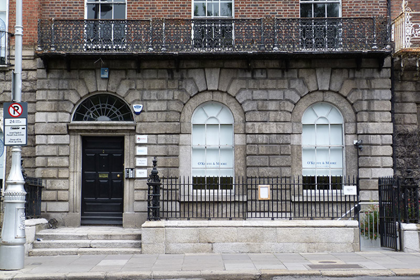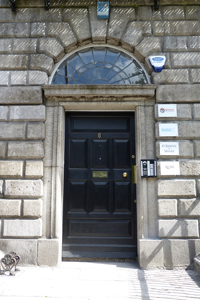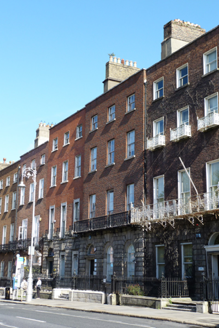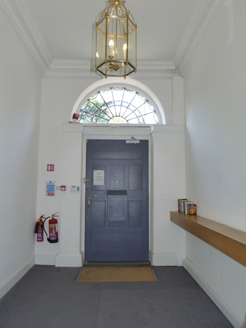Survey Data
Reg No
50100353
Rating
Regional
Categories of Special Interest
Architectural, Artistic
Original Use
House
In Use As
Office
Date
1755 - 1775
Coordinates
316622, 233706
Date Recorded
04/08/2016
Date Updated
--/--/--
Description
Attached three-bay four-storey former house over basement, built c. 1765, having two-bay single-storey over basement addition to rear with narrow projection to two floors above, and with wider multiple-bay single-storey over basement block to rear of latter. Now in use as offices. Pitched slate roof behind refaced brick parapet with granite coping, having shouldered brick and rendered chimneystack to party walls with clay pots, and with cast-iron rainwater goods to east; hipped slate roof to large rear block. Refaced Flemish bond brown brick walls with granite stringcourse above rusticated granite walls to ground floor, and having rendered walls to basement and rear. Square-headed window openings, diminishing in height to upper floors, with painted granite sills. Round-headed window openings to ground floor, recessed within granite reveals and having granite sills; square-headed window openings elsewhere, with timber sliding sash windows, three-over-three pane to top floor and six-over-six pane elsewhere; apparently timber sliding sash windows to rear. Decorative cast-iron balcony to first floor. Round-headed door opening with carved granite surround, granite frieze and cornice, batwing fanlight and eight-panel timber door with brass door furniture. Granite platform with cast-iron boot-scrape and three granite steps. Wrought-iron railings enclosing basement area with decorative wrought and cast-iron corner posts on carved granite plinth wall. Cast-iron coal-hole covers in granite flags to footpath. Interior has entrance hall with simple plasterwork cornice; stairs hall with timber panelling below dado level, timber open-string staircase with turned balusters, ramped mahogany handrail with paired newel posts; return with full-height stained-glass windows, first floor rooms with raised and fielded shutters and soffits to windows, moulded timber architraves to doors with raised and fielded or flat-panel doors, and plaster cornice; front room with neo-Classical frieze and cornice. Two-storey brick building to rear boundary, with vehicular entrance to ground floor and square-headed windows to each floor, and applied lettering to upper part of facade with applied lettering 'J.J. O'Hara & Co. Ltd'.
Appraisal
No. 6 Merrion Square was built by Timothy Turner, an ironsmith. Turner's were possibly responsible for the nineteenth century ornate cast-iron balcony. The brown brick and rusticated granite construction materials provide tonal and textural variation to the façade. It retains a variety of interior plasterwork and joinery, reflecting changes in architectural styles in the nineteenth century. The intact nature of the boundary to the street contributes to the intact appearance of the square. It was built as part of the original development of the square, as part of the Fitzwilliam Estate. Merrion Square is one of the best-preserved Georgian streetscapes in Ireland or Britain. The north, east and south sides of the square are lined with terraced houses of eighteenth and nineteenth-century date, while the west side is terminated by the garden front of Leinster House. The houses maintain a relatively uniform building height and design, attributed to standards promoted in Fitzwilliam's leases. Individuality was introduced through the design of doorcases, window ironwork and interior decorative schemes.

























